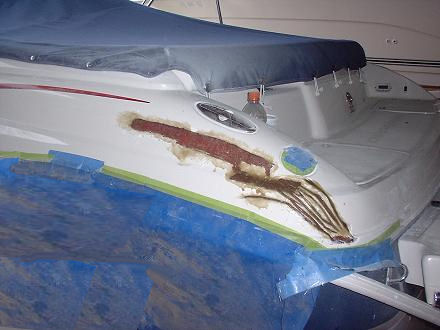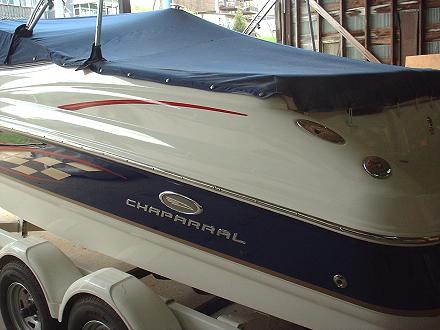All About Fiberglass Boat Stress Cracks
 | This one had some pretty major stress cracks |
 | After the repair we couldn't even find the repair area |
 | No more stress cracks, & the rebuilt area is stronger than factory |
Wow! What a great time we had today, this boat is awesome!’ you think as you step off of your new boat and onto the dock at the marina. Filled with pride and contentment you browse around to see who else is around watching your homecoming with your new cruiser. You reach for your significant others hand to help her off the boat, then the kids. With everyone off the boat and standing safely on the dock you take in a deep breath and with a smile, and you sigh. You stand with your gaze fixed upon the new boat, unable to break your eyes away, regardless of the impatient pleas of the kids to get going, and unaware of “the look” your lady is giving you as she looks at you, then the boat, with her arms folded with a wry look on her face. If looks could kill! But really, you do intend to pay attention to her again at some point in the future! One more quick scan across the surface of the boat and you will get going. With another deep breath and a sigh, you turn to walk away with the family. But after the first step you take in the other direction… something stops you. You quickly turn back to the boat, eyes wide and face flushed… what the heck is that… that crack! You step on the boat and rush over to it for a closer look. But wait, there’s more! One here, one there, and one over there… and one in the sink too! They weren’t there this morning when you left the dealers!
Unfortunately, the scenario above realistically, does happen all too often. Little hairline cracks appearing here and there on the surface of the boat. They can appear anywhere, in and around hatches, sinks, shower stalls, bridges, steering columns, decks, transoms… you name it.
The cause
The causes for stress cracks are much the same as for blistering. We won’t go into great detail here, but suffice it to say that stress cracks occur because of voids under the surface of the gelcoat, and or a lack of strength in the underlying fiberglass or compounds used in the sub structure of the boat. Gel coat hardened too quickly or with improper curing temperatures and conditions can also promote stress cracks in the gel coat itself.
For more details on some of the things that can go wrong in the fiberglass during the manufacturing process please refer to the blistering article. When these voids are present, or when the fiberglass is lacking in strength because it was not mixed properly, or because enough fiberglass was not applied it paves the way for stress cracking. Your boat body will flex some even during normal use. Fiberglass is strong, and if mixed properly, and if enough is applied, the fiberglass will take up much of that flexing. But gelcoat is very brittle and has no strength to it. When the boat flexes and twists, the fiberglass flexes and twists and so does the gel coat. The fiberglass can take a lot of that flexing and twisting, but the gel coat is so brittle it sort of wants to just, well, snap. When that happens, the gelcoat can’t flex with the fiberglass, it just cracks. Hence you get these little hairline cracks in the gel coat surface itself. Other times, maybe a small hairline crack formed in the fiberglass, but this is more rare.
What must be done?
Once a stress crack begins, it can travel for great lengths. Sometimes a short one or two inch stress crack can travel the length of the boat over time. This is because once that fiberglass underneath has flexed, and once the gelcoat has given way, the bond has been broken. A separation has occurred. Then simple heat and sunlight is enough to cause that gelcoat to continue it’s meandering course across the surface of your boat. Stress cracks can be successfully stopped however. The crack must be ground out thoroughly. It needs to be ground deep enough to reach good fiberglass (fiberglass that is not whited out or “shattered” or separated) and it needs to be ground out wide enough to reach the good fiberglass on either side and end. For voids, (a void is a place where the fiberglass had a low spot in it and the gelcoat didn’t touch the fiberglass to bond with it) they need to be ground out and followed down through all the way till the end of the void is reached. Then new fiberglass must be applied. And of course followed up with the finishing touches of shaping and re-gel coating. Normally this process will do away with the stress crack.
Sometimes a stress crack can reappear though, even if all the repair work was done properly. Sometimes if large surface areas are compromised underneath, in the fiberglass, stress cracks can reoccur. Or perhaps there is an entire weak area of fiberglass near the area of the original stress crack. Though the portion you had fixed may be good and strong now, if that fiberglass surrounding the area is weakened and was not properly wetted in the factory, then it is going to flex more than it should and problems are going to continue.
Stress Cracks Suck Water
Water loves to seep into stress cracks. This can pose a few different additional problems. If the area of gelcoat which has a stress crack right there, has fiberglass just under it, well, the hardened fiberglass will keep the water from just seeping into your boat. But while the inside of your boat may be protected because the water can’t get past the fiberglass, it can sit there and it can cause the gel coat to bubble and or lift, and… if your boat sees freezing temperatures in the off season, that water can still be sitting there when you put your boat up for the season. Water caught in between layers, when it freezes, can cause greater damage as it expands. This can mess your gelcoat up pretty badly, and if it happens to be a stress crack that was actually in the fiberglass itself, well this can split your fiberglass and then, gel coat will be the least of the troubles.
Additionally – Many times if it is a stress crack in the fiberglass itself, sometimes this happens over the core materials of certain areas of the boat. Core materials (wood structure, right under the deck, floorboards and walkways) are right under that fiberglass. If there is a crack there and water is seeping in, guess what gets effected… the wood core materials. Then when that water starts getting in and soaking into the wood underneath and sitting there on it and in it, it begins it’s rotting process. How many decks and walkways have we replaced because the wood underneath was rotted and punky! It is always better to deal with stress cracks when you first notice them. Either have it repaired professionally or if you are unable to right now, then at least put something over that crack to keep it sealed. Most often people like to get a tube of silicone and just go along and squish that into the crack till it can be dealt with professionally. This does seem to work for awhile. Pressing silicone down into that crack can cause the technician more work because that silicon has to be ground out and dug out of the crack before it can be repaired but, at least the core materials don’t start soaking and rotting.